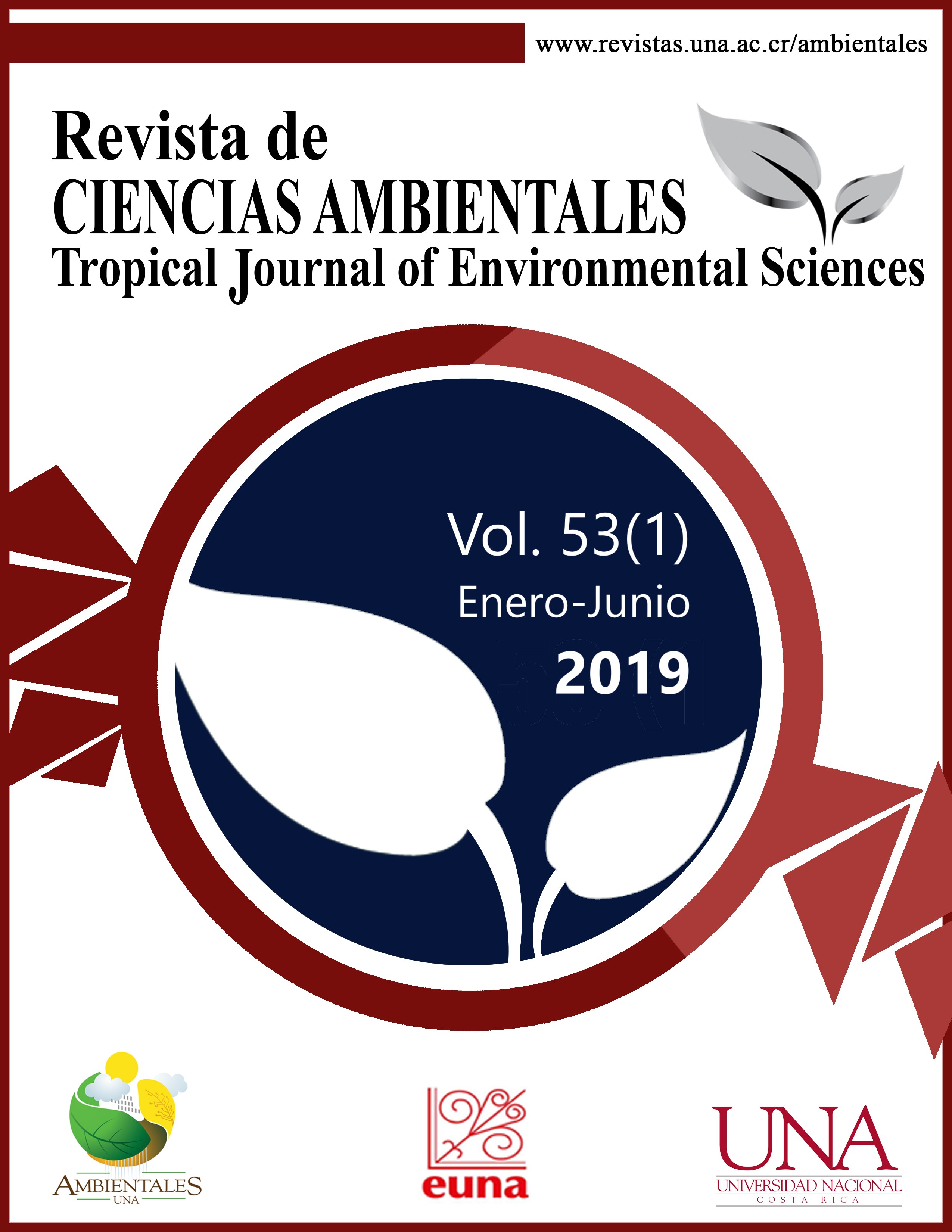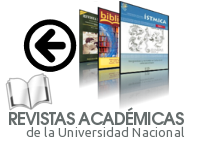Threats and Potential Effects of Climate Change on Free Ranging Populations of White-Tailed Deer (Odocoileus virginianus): A Review on the State of Knowledge
DOI:
https://doi.org/10.15359/rca.53-1.6Keywords:
Climate change; conservation; deer; Odocoileus; ungulates.Abstract
Free-ranging populations of white-tailed deer have shown negative responses to climatic variation within their distribution. The IUCN does not categorize deer populations as endangered species, but climate change is still a threat to this economically and ecologically important species. This study aims to identify and synthesize literature describing the main effects of climate change on white-tailed deer populations. Internet search engines were used to review literature from 2000 to 2016 in topics such as white‑tailed deer and climate. As a result, 18 peer-review papers out of 4,000 were found in the last 16 years, tracking climate responses on the deer population. The main responses based on the literature included changes in deer distribution, increases in the incidence of diseases, changes in movement, changes in population demographics, decreasing of forage quality, and habitat changes. Finally, concluding that information available is limited, restricted to the northern distribution of white-tailed deer, and showing no information on tropical ecosystems beyond Mexico, tools and approaches to assess long‑term effects of climate change on deer populations are urgently needed, specifically in places where the lack of information is evident.
References
Altizer, S., Ostfeld, R. S., Johnson, P. T., Kutz, S., & Harvell, C. D. (2013). Climate change and infectious diseases: from evidence to a predictive framework. Science, 341(6145), 514-519. https://doi.org/10.1126/science.1239401
Bello, J., Gallina, S., & Equihua, M. (2004). Movements of the white-tailed deer and their relationship with precipitation in northeastern Mexico. InterCiencia-Caracas, 29(7), 357-361.
Brinkman, T. J., Deperno, C. S., Jenks, J. A., Haroldson, B. S., & Osborn, R. G. (2005). Movement of female white-tailed deer: effects of climate and intensive row-crop agriculture. Journal of Wildlife Management, 69(3), 1099-1111. https://doi.org/10.2193/0022-541X(2005)069[1099:MOFWDE]2.0.CO;2
Boyle M., Knopff K., Northrup j., Pitt J. & Vors L. (2013). Harvest models for changing enviroments. In J. F.Brodie, E. S. Post, & D. F. Doak (Eds.). Wildlife conservation in a changing climate, 293-306. Chicago.
Dawe, K. L., & Boutin, S. (2016). Climate change is the primary driver of white tailed deer (Odocoileus virginianus) range expansion at the northern extent of its range; land use is secondary. Ecology and Evolution, 6(18), 6435-6451. https://doi.org/10.1002/ece3.2316
Dawe, K. L., Bayne, E. M., & Boutin, S. (2014). Influence of climate and human land use on the distribution of white-tailed deer (Odocoileus virginianus) in the western boreal forest. Canadian Journal of Zoology, 92(4), 353-363. https://doi.org/10.1139/cjz-2013-0262
Dawson, T. P., Jackson, S. T., House, J. I., Prentice, I. C., & Mace, G. M. (2011). Beyond predictions: biodiversity conservation in a changing climate. Science, 332(6025), 53-58. https://doi.org/10.1126/science.1200303
DeGregorio, B. A., Westervelt, J. D., Weatherhead, P. J., & Sperry, J. H. (2015). Indirect effect of climate change: Shifts in ratsnake behavior alter intensity and timing of avian nest predation. Ecological Modelling, 312, 239-246. https://doi.org/10.1016/j.ecolmodel.2015.05.031
Eguiguren-Velepucha P., Chamba J., Aguirre N., Ojeda-Luna, T., Samaniego-Rojas, Furniss M., Howe C & Aguirre Z. (2016). Tropical ecosystems vulnerability to climate change in southern Ecuador. Tropical Conservation Science, 9(4), 1-17. https://doi.org/10.1177/1940082916668007
Estrada-Peña, A., Carreón, D., Almazán, C., & de la Fuente, J. (2014). Modeling the impact of climate and landscape on the efficacy of white tailed deer vaccination for cattle tick control in northeastern Mexico. PloS one, 9(7), e102905. https://doi.org/10.1371/journal.pone.0102905
Estrada-Peña, A., Ostfeld, R. S., Peterson, A. T., Poulin, R., & de la Fuente, J. (2014). Effects of environmental change on zoonotic disease risk: an ecological primer. Trends in Parasitology, 30(4), 205-214. https://doi.org/10.1016/j.pt.2014.02.003
Feria-Arroyo, T. P., Castro-Arellano, I., Gordillo-Pérez, G., Cavazos, A. L., Vargas-Sandoval, M., Grover, A. & Esteve-Gassent, M. D. (2014). Implications of climate change on the distribution of the tick vector Ixodes scapularis and risk for Lyme disease in the Texas-Mexico transboundary region. Parasites & vectors, 7(1), 1. https://doi.org/10.1186/1756-3305-7-199
Fieberg, J., Kuehn, D. W., & DelGiudice, G. D. (2008). Understanding variation in autumn migration of northern white-tailed deer by long-term study. Journal of Mammalogy, 89(6), 1529-1539. https://doi.org/10.1644/07-MAMM-A-277.1
Fordham, D. A., Akçakaya, H. R., Araújo, M. B., Keith, D. A., & Brook, B. W. (2013). Tools for integrating range change, extinction risk and climate change information into conservation management. Ecography, 36(9), 956-964. https://doi.org/10.1111/j.1600-0587.2013.00147.x
Frelich, L. E., Peterson, R. O., Dovčiak, M., Reich, P. B., Vucetich, J. A., & Eisenhauer, N. (2012). Trophic cascades, invasive species and body-size hierarchies interactively modulate climate change responses of ecotonal temperate–boreal forest. Philosophical Transactions of the Royal Society of London B: Biological Sciences, 367(1605), 2955-2961. https://doi.org/10.1098/rstb.2012.0235
Fuller, T. K. (1990). Dynamics of a declining white-tailed deer population in north-central Minnesota. Wildlife Monographs, 3-37.
Gallina, S. and López Arévalo, H. (2016). Odocoileus virginianus. The IUCN Red List of Threatened Species 2016: e.T42394A22162580. Downloaded on 21 November 2016.
Garroway, C. J., & Broders, H. G. (2005). The quantitative effects of population density and winter weather on the body condition of white-tailed deer (Odocoileus virginianus) in Nova Scotia, Canada. Canadian Journal of Zoology, 83(9), 1246-1256. https://doi.org/10.1139/z05-118
Hoving, C. L., & Notaro, M. (2015). Ice, Snow, and Swamp: Managing Deer in Michigan’s Changing Climate. Michigan Journal of Sustainability, 3. DOI: http://dx.doi.org/10.3998/mjs.12333712.0003.008
Intergovernmental Plan on Climate Change [IPCC]. (2014). Climate Change 2014: Synthesis Report. Contribution of Working Groups I, II and III to the Fifth Assessment Report of the Intergovernmental Panel on Climate Change [Core Writing Team, R.K. Pachauri and L.A. Meyer (eds.)]. IPCC, Geneva, Switzerland, 151 pp. Recuperado de https://www.weadapt.org/sites/weadapt.org/files/legacy-new/knowledge-base/files/5554becc27072ar5-syr-final-all-topics.pdf
Jaramillo, V. J., Martínez-Yrízar, A., & Sanford Jr. (2011). Primary productivity and biogeochemistry of seasonally dry tropical forests. In Dirzo R., Young H. S., Mooney H. A., & G. Ceballos (Eds.), Seasonally dry tropical forests (pp. 109-128). Washington D.C. https://doi.org/10.5822/978-1-61091-021-7_7
Kareiva, P. M. M. (2011). Conservation science balancing the needs of people and nature. Greenwood Village.
Lashley, M. A., & Harper, C. A. (2012). The effects of extreme drought on native forage nutritional quality and white-tailed deer diet selection. Southeastern Naturalist, 11(4), 699-710. https://doi.org/10.1656/058.011.0409
Latham, A. D. M., Latham, M. C., McCutchen, N. A., & Boutin, S. (2011). Invading white-tailed deer change wolf–caribou dynamics in northeastern Alberta. The Journal of Wildlife Management, 75(1), 204-212. https://doi.org/10.1002/jwmg.28
Lesage, L., Crête, M., Huot, J., Dumont, A., & Ouellet, J. P. (2000). Seasonal home range size and philopatry in two northern white-tailed deer populations. Canadian Journal of Zoology, 78(11), 1930-1940. https://doi.org/10.1139/z00-117
Lishawa, S. C., Bergdahl, D. R., & Costa, S. D. (2007). Winter conditions in eastern hemlock and mixed-hardwood deer wintering areas of Vermont. Canadian Journal of Forest Research, 37(3), 697-703. https://doi.org/10.1139/X06-256
McDonald, J., Christensen, S., Deblinger, R. and Woytek, W., (2009). An alternative to climate change for explaining species loss in Thoreau's woods. Proceedings of the National Academy of Sciences, pp.pnas-0811954106. https://doi.org/10.1073/pnas.0811954106
McDonald, J., Christensen, S., Deblinger, R., & Woytek, W. (2009). An alternative to climate change for explaining species loss in Thoreau's woods. Proceedings of the National Academy of Sciences, pnas-0811954106. https://doi.org/10.1073/pnas.0811954106
Newman, J. A. (2011). Climate change biology. Massachusetts, CABI. https://doi.org/10.1079/9781845937485.0000
Ogutu, J. O., Piepho, H. P., & Dublin, H. T. (2015). Reproductive seasonality in African ungulates in relation to rainfall. Wildlife Research, 41(4), 323-342. https://doi.org/10.1071/WR13211
Olson, D. D., Bissonette, J. A., Cramer, P. C., Bunnell, K. D., Coster, D. C., & Jackson, P. J. (2015). How does variation in winter weather affect deer—vehicle collision rates. Wildlife Biology, 21(2), 80-87. https://doi.org/10.2981/wlb.00043
Ostfeld, R. S., Canham, C. D., Oggenfuss, K., Winchcombe, R. J., & Keesing, F. (2006). Climate, deer, rodents, and acorns as determinants of variation in Lyme-disease risk. PLoS, 4(6), e145. https://doi.org/10.1371/journal.pbio.0040145
Owen-Smith N., Mason R., & J. Ogutu. (2005). Correlates of survival rates for 10 African ungulate populations: density, rainfall and predation. Journal of Animal Ecology, 74(4), 774-788. https://doi.org/10.1111/j.1365-2656.2005.00974.x
Patterson, B. R., & Power, V. A. (2002). Contributions of forage competition, harvest, and climate fluctuation to changes in population growth of northern white-tailed deer. Oecologia, 130(1), 62-71. https://doi.org/10.1007/s004420100783
Sabine, D. L., Morrison, S. F., Whitlaw, H. A., Ballard, W. B., Forbes, G. J., & Bowman, J. (2002). Migration behavior of white-tailed deer under varying winter climate regimes in New Brunswick. The Journal of Wildlife Management, 718-728. https://doi.org/10.2307/3803137
Simard, M. A., Coulson, T., Gingras, A., & Côté, S. D. (2010). Influence of density and climate on population dynamics of a large herbivore under harsh environmental conditions. The Journal of Wildlife Management, 74(8), 1671-1685. https://doi.org/10.2193/2009-258
Sleeman, J. M., Howell, J. E., Knox, W. M., & Stenger, P. J. (2009). Incidence of hemorrhagic disease in white-tailed deer is associated with winter and summer climatic conditions. EcoHealth, 6(1), 11-15. https://doi.org/10.1007/s10393-009-0220-6
Stoner, K. E., & Timm, R. M. (2011). Seasonally dry tropical forest mammals: Adaptations and seasonal patterns. In R. Dirzo, H, S. Young, H. A. Mooney, & G. Ceballos (Eds.), Seasonally dry tropical forests (pp. 85-106). Washington D.C. https://doi.org/10.5822/978-1-61091-021-7_6
Taillon, J., Sauvé, D. G., & Côté, S. D. (2006). The Effects of Decreasing Winter Diet Quality on Foraging Behavior and Life-History Traits of White-Tailed Deer Fawns. The Journal of Wildlife Management, 1445-1454. https://doi.org/10.2193/0022-541X(2006)70[1445:TEODWD]2.0.CO;2
Vors, L. S., & Boyce, M. S. (2009). Global declines of caribou and reindeer. Global Change Biology, 15(11), 2626-2633. https://doi.org/10.1111/j.1365-2486.2009.01974.x
Webb, S. L., Hewitt, D. G., & Hellickson, M. W. (2007). Scale of Management for Mature Male White Tailed Deer as Influenced by Home Range and Movements. The Journal of Wildlife Management, 71(5), 1507-1512. https://doi.org/10.2193/2006-300
Young B., Dubois N. & Rowland E. (2014). Using the climate change vulnerability index to inform adaptation planning: Lessons, innovations, and next steps: Using the Climate Change Vulnerability Index. Wildlife Society Bulletin, 39(1), 1-8.
Downloads
Published
How to Cite
Issue
Section
License

This work is licensed under a Creative Commons Attribution-NonCommercial-ShareAlike 4.0 International License.



















